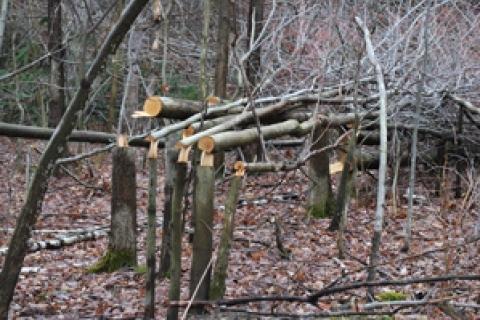
Winter is a great time to tune up your whitetail hunting woods. A few weekends and a few friends with chainsaws can mean the difference between a great next season and another year of coming up empty. Here a few projects you can do to get you up off the couch and into the deer habitat business.
 |
| Tree tops left on the ground to rot provide a caging effect that allows native tree species to regenerate. |
The first thing you will need is a piece of deer ground to work with and some deer in the area to attract. Then you will need a chain saw and some safety equipment to go with it. Eye and hearing protection are mandatory, as are chain saw chaps, heavy gloves, and boots. Cutting in the woods can be dangerous, especially for those inexperienced with chainsaws.
You can either work in the deep woods or on the edges, either way, you will be benefiting whitetails by putting trees on the ground and allowing sunlight to warm the earth and begin the growing process all over again. Here are a few pointers for improving your whitetail habitat this winter.
Create Thick Cover Openings for Deer Food to Grow
It's important to understand that most of a deer's food exists within 6 feet of the ground. Deer feed on forbs, leaves, grasses, and browse stems. When limbs within reach of deer are repeatedly browsed off, trees shift their growth energy elsewhere and the new growth sprouts above the deer's reach. The food source disappears or worse, dies. Natural regenerating brambles and young tree stems are all very good food sources, but they grown at ground level and require lots of sunlight to prosper. Sunlight is the key and the way to get sunlight on the ground is to thin the over story. Sunlight on the ground will turn an area with no food and cover into a whitetail Mecca. Cut, and cut some more.
Try to create little pockets of cover 50 to 60 yards across throughout your property. Arrange them along known buck travel routes. These areas of structure will attract does, creating a prime environment for hunting for bucks. During the pre-rut and rut, bucks will go from structure to structure searching for that doe in heat. The goal in these small cuts, which cover up to 1 acre or so, is to maximize food diversity and create cover. If laid out correctly, it will help you pattern bucks as they move from doe hole to doe hole.
Leave Tree Tops on the Ground
Tops left on the ground to rot provide a caging effect that allows native tree species to regenerate. Deer choose not to walk through the downed tree tops because of their density. This reduces browsing dramatically. The spaces between limbs become protected nurseries for regenerating trees and shrubs. If your deer densities are high, tree tops will have to be left intact if you have any chance of achieving forest regeneration. That means no firewood cutting.
Treetops and limbs can also be stacked to create habitat for all kinds of critters. Build your wildlife brush pile by putting the largest logs on the bottom and stacking brush to about 6 feet high. This setup attracts rabbits and other small game.
The most effective way to lay out a browse-cut and create structure is to make a series of quarter- to half-acre cuts in a wooded area, felling most of the trees. Drop all the trees into a few strategically chosen target areas, creating small, dense structures. The area under the tops will regenerate tree growth, while the unprotected area should produce knee-high ground growth around the outer fringe. Another approach is to cut long "power lines" through the woods, which will become browse and travel corridors. We like to cut 50 yards wide. Mature bucks will generally travel slightly downwind of these types of cuts in order to keep track of the does using the cuts.
Create Living Brush Piles for the Deer
Living brush piles are a great way to attract whitetails and just about anything else that lives in the woods. We create living brush piles by dropping small trees or shrubs without cutting them clear through. We do this by felling small trees with a cut that doesn't sever it from the stump. The tree will lie on the ground and remain alive for perhaps a few years, providing thick cover and nutritious browse. Small trees in the 3- to 6-inch range respond better to this treatment than do large ones. This maximizes the amount of food tonnage, and provides cover for other wildlife. The hinge should be about waist high to help prop up the next tree you cut. Living brush piles are great nesting cover and feed deer; they work great to redirect deer closer to your stand. You can also push over small trees with a bulldozer or tractor to create living brush piles. These will live even longer.
Get off the Couch
There is no reason to be sitting around doing nothing this winter waiting for spring. An ongoing habitat improvement program will improve your deer hunting and give you something to look forward to after deer season. The trick is to get out there and get busy it's easier than you think. My new book Whitetails: From Ground to Gun is full of tips for improving whitetail habitat. It is available at Bass Pro Shops everywhere.
- 3617 views

